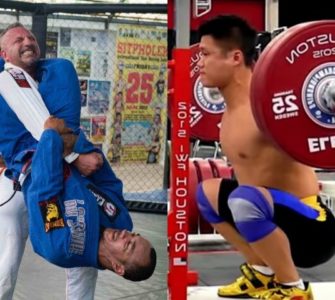Photo: Nelson Puentes of Inverted Gear.
Written By Guillaume Huni, BJJ black belt and head instructor of Kimura Academy in Serbia.
Footlocks in Jiu-Jitsu seem to get a bad rap. In other similar grappling arts like Sambo or Catch Wrestling, they occupy an important place.
In recent years a new school of Jiu-Jitsu players have started to perfect the leg lock game (Garry Tonon or Eddie Cummings in No Gi and Luis Panza, Cavaca in Gi) but they are still not developed so much in Jiu-Jitsu and many people still see them as cheap, low class moves or are frowned upon because of high risk of injury (especially heel hooks) . Why would that be?
I remember training in Brazil 10 years ago as a blue belt with very limited techniques. I was very often going for footlocks against guys who were much more skilled than me. I had some success at it, but one day one of the black belts gave me a sincere piece of advice. He told me:
“I’ve been watching you going for everybody’s foot in training. You are quite good at footlocks however the rest of game is very poor and your open guard sucks. When the guy defends your footlock and gets on top, your guard is so week that he almost immediately passes.”
He was absolutely right. I had been spending much less time on developing more important aspects of my game like developing a good guard, guard passing, and improving position, and had just been focusing on getting the easiest submission available: The foot lock while passing the guard.
At my BJJ school, we allow foot locks at all level, but there is a reason that we do not encourage white belts to go for footlocks in training. There is a higher risk of injury since beginners still have less control of their actions. Another reason is because they will focus less on developing solid basics.
In my opinion, footlocks are just another weapon in Jiu-Jitsu and should be treated as such. They are however very useful especially against guys who don’t work on them often. Work on them but until you reach a certain advanced level, don’t just focus your whole game on them.
World champion Marcio Feitosa has this to say about footlocks in Jiu-Jitsu in his interview with Grapplearts
“It’s true that footlocks don’t let the game flow as nice as it can flow, but they are moves just like any other moves. The only thing we tell our students not to use is anything that rotates the knee to the inside – it’s not that we don’t like that move either, it’s because it can damage your partner. With the rotation when you feel the pain your knee is already injured, so that is why we stopped teaching this move. We also don’t teach the cervical (spine lock) because you can hurt someone really badly with it.It is harder to get an arm, because it’s so slippery, and other things too. When you train footlocks with the gi you must be much more technical, because the other guy will grab your collar and be able to defend much better. If he does this you can get tired trying to pull his foot all the time.
Without the gi it’s harder for the person to defend. Your foot is slippery, but once the guy catches it is harder to defend, since you don’t have the gi to hold. Also without the gi you have less submissions – you don’t have the collar to use all the time, so you have fewer armlocks and chokes, so you use more footlocks, kneebars and leglocks.”
So the important thing is work on footlocks, because it’s always useful to be able to slap on a fast submission when you need one (for ex: time running out and you’re down on points) but always remember the old saying “position before submission”.



















